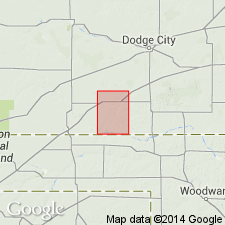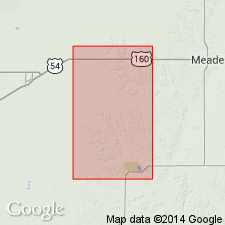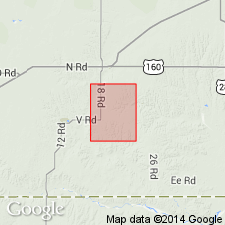
- Usage in publication:
-
- Vanhem formation
- Modifications:
-
- Original reference
- Dominant lithology:
-
- Sand
- Gravel
- Silt
- Loess
- AAPG geologic province:
-
- Anadarko basin
Summary:
Pg 69 (fig. 1), 84-87. Vanhem formation. Proposed for sediments laid down during cycle of deposition which followed entrenchment of streams into Kingsdown and older formations. Includes following lithologic units (ascending): (1) sand and gravel; (2) silt, (3) silt to clayey silt, and (4) loess. Thickness at type section 68 feet. Type section of the Vanhem is the section given by Smith (1940) as a typical section of the Kingsdown. Most exposures previously referred to or mapped as Kingsdown silt are of deposits younger than the Kingsdown formation and are part of the Vanhem. Fossils; carries Jones local fauna [Jones Ranch beds of Smith, 1940]. Age is Pleistocene.
Type locality: in N/2 sec. 13 and S/2 sec. 12, T. 30 S., R. 23 W., Pyle Ranch (Stephenson Ranch) on north side of Bluff Creek, Clark Co., southwestern KS.
Type section: along west bluff of a small tributary of Bluff Creek, in secs. 12 and 13, T. 30 S., R. 23 W., Clark Co., southwestern KS (Smith's 1940 typical section of Kingsdown); in sec. 13, T. 30 S., R. 23 W., Clark Co., southwestern KS (modifed after Smith, 1940, p. 112).
Named from Vanhem Post Office in N/2 sec. 13, T. 30 S., R. 23 W., Clark Co., southwestern KS.
One of better exposures occurs at top of a bluff on Jones Ranch, in sec. 8, T. 33 S., R. 27 W., Meade Co., southwestern KS; Jones local fauna occurs 16 ft below top of bluff.
Source: Publication; US geologic names lexicon (USGS Bull. 1200, p. 4055-4056).

- Usage in publication:
-
- Vanhem formation*
- Modifications:
-
- Revised
- AAPG geologic province:
-
- Anadarko basin
Summary:
Pg. 55 (fig. 1). Vanhem Formation of Sanborn group. Revised to upper formation of Sanborn group in southwestern Kansas. [Age is Pleistocene and Recent.]
Source: US geologic names lexicon (USGS Bull. 1200, p. 4055-4056).

- Usage in publication:
-
- Vanhem Formation
- Modifications:
-
- Not used
- AAPG geologic province:
-
- Anadarko basin
Summary:
Vanhem Formation. Strata included in unnamed Pleistocene deposits. [Plio-Pleistocene boundary placed at 1.8 Ma.]
Source: Publication.
- Usage in publication:
-
- Vanhem Formation*
- Modifications:
-
- Not used
- AAPG geologic province:
-
- Anadarko basin
Martin, R.A., Honey, J.G., and Pelaez-Camponanes, Pablo, 2000, The Meade basin [Kansas] rodent project; a progress report: Paludicola, v. 3, no. 1, p. 1-32.
Summary:
Deposits of the Vanhem Formation of Hibbard and Taylor (1960) and Zakrzewski (1975) are included in unnamed Pleistocene and Recent deposits; they contain Pleistocene (Rancholabrean NALMA) Robert, Jones, Jinglebob, Cragin Quarry, and Mt. Scott local faunas.
Source: Publication.
For more information, please contact Nancy Stamm, Geologic Names Committee Secretary.
Asterisk (*) indicates published by U.S. Geological Survey authors.
"No current usage" (†) implies that a name has been abandoned or has fallen into disuse. Former usage and, if known, replacement name given in parentheses ( ).
Slash (/) indicates name conflicts with nomenclatural guidelines (CSN, 1933; ACSN, 1961, 1970; NACSN, 1983, 2005, 2021). May be explained within brackets ([ ]).

